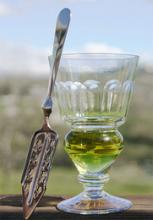People love telling myths about alcohol. I don't know what it is about the stuff, but it's the subject of more tall tales than perhaps any other substance on the planet. Every long-time bartender has some entirely fictional story about how the Margarita was invented by a lovelorn Mexican poet who named it after the woman he could never have, or how Jack Daniels whiskey is the result of an epic Civil War era odyssey that nearly ended in the destruction of the original recipe for bourbon. It's easy to get dragged into these stories, perhaps because we want to believe there's something special about the things we drink. I suppose that's why the lies concocted about absinthe in the late 19th century persist into the modern day. What was once a smear campaign designed to scare people away from The Green Fairy transformed into the granddaddy of all psychedelic legends. It's almost too bad that none of it is true.
So, what is absinthe exactly? Well, it's an anise-flavored herbal spirit that originated in Switzerland some time in the past two or three hundred years. It gets its name from the main herbal component of its recipe, the Artemisia absinthium, a species of the wormwood plant that has been used for various ends such as stomach medicine, a scent agent in pesticides and, of course, flavoring in alcoholic beverages. The idea that absinthe is a hallucinogenic comes from the convenience of an easy to pronounce but sinister-sounding chemical called Thujone.
Thujone is a chemical that appears in a variety of commonly consumed plants, including several members of the mint family. Modern medical tests have concluded that a dangerous dose of thujone measures around 50-60 mg (though no extensive human testing has been performed) while high but non-lethal doses resulted in some spasms and convulsions. Sounds pretty beastly, right? Yeah, it's not. Even the so-called "high wormwood" batches that were considered top-shelf back in the drink's glory days only reached an average of 25 mg of thujone per bottle and the same toxicology tests showed that the presence of ethanol (that's drinking alcohol for those who are playing catch-up) could make a dose as high as 100 mg non-lethal. So, it seems that everything truly suspect about thujone is effectively neutralized by the fact that absinthe is an alcoholic beverage.
Then why do so many people believe that absinthe is some insane, Victorian-era LSD? Two words: Temperance Movement. Absinthe was popular with the members of the counterculture, especially in France in the 1890's. As a symbol of the bohemian lifestyle, absinthe was an easy target for the political entities who wanted to ban alcohol outright. The teetotalers concocted a wide variety of lies about absinthe in what ended up being one of the most successful negative PR campaigns in history. Just like Reefer Madness convinced an entire subsection of Americans that marijuana will turn people into baby-killing psychopaths, the absinthe lies created a legend about a fairly innocuous drink that made it illegal both before and after the Prohibition movement won big in America.
These days you can get a bottle of absinthe with relative ease. Many Europeans countries lifted their bans in the 1990's and America followed suit just a few years ago. There's still a lot of theater surrounding absinthe. A lot of companies are marketing mostly unnecessary accessories like so-called "absinthe glasses" and the iconic perforated sugar spoon. Today's absinthe should still probably be consumed in a diluted form, but that's just because a lot of varieties still come in ridiculously high ABV proportions. If you've got a taste for the stuff, make sure to check your bottle first before you pour water into a weak, 70 proof glass of Green Fairy. And don't expect any visuals. You're not drinking any drug you won't find in a glass of vodka.
